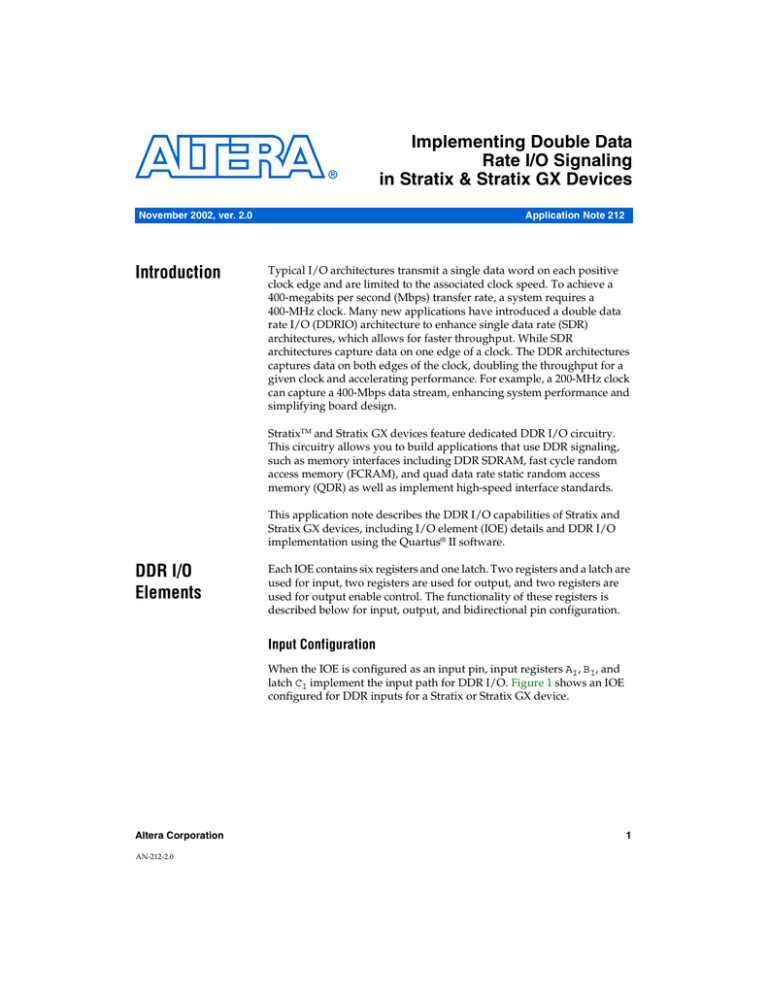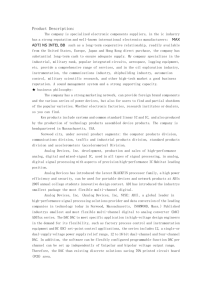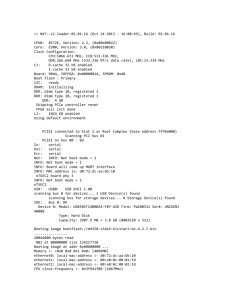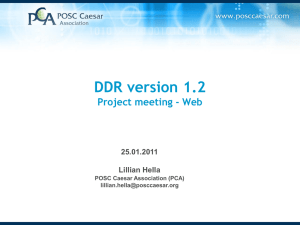
Implementing Double Data
Rate I/O Signaling
in Stratix & Stratix GX Devices
November 2002, ver. 2.0
Introduction
Application Note 212
Typical I/O architectures transmit a single data word on each positive
clock edge and are limited to the associated clock speed. To achieve a
400-megabits per second (Mbps) transfer rate, a system requires a
400-MHz clock. Many new applications have introduced a double data
rate I/O (DDRIO) architecture to enhance single data rate (SDR)
architectures, which allows for faster throughput. While SDR
architectures capture data on one edge of a clock. The DDR architectures
captures data on both edges of the clock, doubling the throughput for a
given clock and accelerating performance. For example, a 200-MHz clock
can capture a 400-Mbps data stream, enhancing system performance and
simplifying board design.
StratixTM and Stratix GX devices feature dedicated DDR I/O circuitry.
This circuitry allows you to build applications that use DDR signaling,
such as memory interfaces including DDR SDRAM, fast cycle random
access memory (FCRAM), and quad data rate static random access
memory (QDR) as well as implement high-speed interface standards.
This application note describes the DDR I/O capabilities of Stratix and
Stratix GX devices, including I/O element (IOE) details and DDR I/O
implementation using the Quartus II software.
DDR I/O
Elements
Each IOE contains six registers and one latch. Two registers and a latch are
used for input, two registers are used for output, and two registers are
used for output enable control. The functionality of these registers is
described below for input, output, and bidirectional pin configuration.
Input Configuration
When the IOE is configured as an input pin, input registers AI, BI, and
latch CI implement the input path for DDR I/O. Figure 1 shows an IOE
configured for DDR inputs for a Stratix or Stratix GX device.
Altera Corporation
AN-212-2.0
1
AN 212: Implementing Double Data Rate I/O Signaling in Stratix & Stratix GX Devices
Figure 1. Input DDR I/O Path Configuration
DFF
dataout_l
D
INPUT
Q
Input Reg A I
DFF
Data_in
Logic
Array
LALatch
TCH
dataout_h
neg_reg_out
D
Q
D
Q
ENA
Input Reg B I
Latch C I
inclock
On the rising edge of the clock, the positive-edge triggered register (AI)
acquires the first bit of data. On the corresponding falling edge of the
clock, the negative-edge triggered register (BI) acquires the second bit of
data. For a successful data transfer to the logic array, the latch (CI)
synchronizes the data from register BI to the positive edge of the clock.
Output Configuration
The dedicated output registers for Stratix and Stratix GX devices are
labeled AO and BO. These positive-edge triggered registers and a
multiplexer are used for implementing the output path for DDR I/O.
Figure 2 shows the IOE configuration for DDR outputs in Stratix and
Stratix GX devices.
2
Altera Corporation
AN 212: Implementing Double Data Rate I/O Signaling in Stratix & Stratix GX Devices
Figure 2. Output DDR I/O Path Configuration
DFF
oe
D
Q
OE Reg A OE (2)
OR2
DFF
D
Logic Array
Q
OE Reg B OE (1)
DFF
datain_l
D
Q
TRI
Output Reg Ao
0
1
OUTPUT
dataout
DFF
datain_h
D
outclock
Q
Output Reg Bo
Notes to Figure 2:
(1)
(2)
Register BOE generates the delayed enable signal for DDR SDRAM applications.
Register AOE generates the enable signal for general-purpose DDR I/O applications.
On the positive edge of the clock, two consecutive data bits are captured
in registers Ao and Bo. The outputs of these two registers are fed to the
inputs of a 2-to-1 multiplexer, which uses the output register clock as its
control signal. A high clock selects the data in register Bo, and a low level
of the clock selects the data in register Ao. This process doubles the data
rate.
Altera Corporation
3
AN 212: Implementing Double Data Rate I/O Signaling in Stratix & Stratix GX Devices
Bidirectional Configuration
Input and output registers are independent and enable the bidirectional
DDR I/O path can be implemented entirely in the I/O element. The
bidirectional configuration includes an input path, an output path, and
two output enable registers. The bidirectional path consists of two data
flow paths: input path active and output path active.
When the input path is active, the output enable disables the tri-state
buffer, which prevents data from being sent out on the output path.
Disabling the tri-state buffer prevents contention at the I/O pin. The input
path behaves like the input configuration as shown in Figure 1 on page 2.
During output transactions, the output enable register Aoe controls the
flow of data from the output registers. During outgoing transactions, the
bidirectional configuration behaves like the output configuration as
shown in Figure 2.
The DDR I/O input registers can be bypassed in the bidirectional
dataflow. For example, the output registers may be used while the input
pin drives into the logic array, bypassing the input registers.
The second output enable register (BOE) is used for DDR SDRAM
interfaces. This negative-edge register extends the high-impedance state
of the pin by a half clock cycle. This feature is enabled by using the
altddio_bidir megafunction in the Quartus II software. Figure 3
shows the bidirectional DDR I/O configuration for Stratix and Stratix GX
devices.
f
4
For more information on DDR I/O megafunctions, see the “DDR I/O
Megafunctions” on page 7.
Altera Corporation
AN 212: Implementing Double Data Rate I/O Signaling in Stratix & Stratix GX Devices
Figure 3. Bidirectional DDR I/O Path Configuration
DFF
oe
D
Q
OE Reg A OE
OR2
DFF
D
Q
OE Reg B OE (1)
DFF
datain_l
D
Q
0
1
Output Reg Ao
TRI
I/O Pin
DFF
Logic Array
datain_h
D
Q
Output Reg Bo
outclock
DFF
dataout_l
Q
D
Input Reg A I
Latch
TCH
LA
dataout_h
Q
D
DFF
neg_reg_out
Q
D
ENA
Latch C I
Input Reg B
I
inclock
Note to Figure 3:
(1)
Register BOE generates the delayed enable signal for DDR SDRAM applications.
Altera Corporation
5
AN 212: Implementing Double Data Rate I/O Signaling in Stratix & Stratix GX Devices
f
For more information about clock signals and output enable signals for
Stratix or Stratix GX devices, see the Stratix Device Family Data Sheet or the
Stratix GX FPGA Family Data Sheet.
DDR I/O Timing
Figure 4 shows the functional timing waveform for the input path. The
signal names are the port names used in the altddio_in megafunction.
The signal data_in is the input from the pin to the DDR circuitry.
neg_reg_out is the output of register BI. dataout_h is the output of
latch CI and dataout_l is the output of register AI. dataout_h and
dataout_l feed the core and illustrate the conversion of the data from a
DDR implementation to positive-edge triggered data.
Figure 4. DDR I/O Input Timing Waveform
inclock
data_in
neg_reg_out
XX
D0
XX
E0
D1
E1
D2
D1
D0
D3
E2
D2
dataout_h
XX
D0
D1
dataout_l
XX
E0
E1
D3
D2
E2
The functional timing waveform for the output path is shown in Figure 5.
The output enable oe can be driven from a pin or internal logic. The oe
signal feeds the output enable register (Aoe) and output enable register
(BOE). When oe is high, the output is tristated. The data signals datain_l
and datain_h are driven from the logic array to output registers Ao and
Bo. The signal data_out is the output from the DDR circuitry to the pin.
Figure 5. DDR I/O Output Timing Waveform
outclock
oe
mux
control signal
datain_l
XX
D0
datain_h
XX
E0
dataout
6
XX
E0
D1
D2
E1
D0
E1
D3
E3
E2
D1
ZZ
Altera Corporation
AN 212: Implementing Double Data Rate I/O Signaling in Stratix & Stratix GX Devices
DDR I/O
Megafunctions
You can implement DDR I/O interfaces in the Quartus II software using
the altddio_in, altddio_out, and altddio_bidir megafunctions.
The megafunction altddio_in is used for the DDR I/O input path,
altddio_out is used for the DDR I/O output path, and
altddio_bidir is used for the DDR I/O bidirectional path. These
megafunctions allow you to customize DDR I/O parameters.
altddio_in
The altddio_in megafunction configures the Stratix or Stratix GX IOE
for DDR inputs. Tables 1, 2, and 3 show the port names and parameters
for altddio_in. The options listed in these tables are valid for Stratix
and Stratix GX devices. Other ports and parameters are available if you
select a different device family.
Table 1. altddio_in Input Ports
Name
Required
Description
Comments
data_in[]
Yes
DDR input data port.
Input port WIDTH wide. The data_in port
should be directly fed from an input pin in
the top level design.
inclock
Yes
Clock signal to sample the DDR The data_in port is sampled on each
input.
clock edge of the inclock signal.
inclocken
No
Clock enable for the data clock.
aclr
No
Asynchronous clear input.
The aclr port and the aset port cannot
be connected at the same time.
aset
No
Asynchronous preset input.
The aclr port and the aset port cannot
be connected at the same time.
Table 2. altddio_in Output Ports
Name
Altera Corporation
Required
Description
dataout_h[]
Yes
Data sampled from the data_in[] port at
the falling edge of the inclock signal.
dataout_l[]
Yes
Data sampled from the data_in[] port at
the rising edge of the inclock signal.
7
AN 212: Implementing Double Data Rate I/O Signaling in Stratix & Stratix GX Devices
Table 3. altddio_in Parameters
Type
Required
Description
WIDTH
Parameter
Integer
Yes
Width of the data_in, dataout_h, and dataout_l
ports
POWER_UP_HIGH
String
No
When both the aset and aclr ports are unused, the
POWER_UP_HIGH parameter can specify the powerup state of the output ports. Values are ON and OFF.
The default setting is OFF.
INTENDED_DEVICE_FAMILY
String
No
This parameter is used for modeling and behavioral
simulation. Create the altddio_in megafunction
with the MegaWizard® Plug-in Manager to calculate
the value for this parameter.
altddio_out
The altddio_out megafunction configures the Stratix or Stratix GX IOE
for DDR outputs. Tables 4, 5, and 6 show the port names and parameters
for altddio_out. The options listed in these tables are valid for Stratix
and Stratix GX devices. Other ports and parameters can be available if you
select a different device family.
Table 4. altddio_out Input Ports
Required
Description
datain_h[]
Name
Yes
Input data, which is output on the
high level of the outclock port.
Input port WIDTH wide.
datain_l[]
Yes
Input data, which is output on the
low level of the outclock port.
Input port WIDTH wide.
outclock
Yes
Clock signal to register the data
output.
The dataout port outputs the DDR
data on each level of the outclock
signal.
outclocken
No
Clock enable for the outclock
port.
aclr
No
Asynchronous clear input.
The aclr port and the aset port
cannot be connected at the same
time.
aset
No
Asynchronous set input.
The aclr port and the aset port
cannot be connected at the same
time.
oe
No
Output enable for the dataout
port.
Active-low signal.
8
Comments
Altera Corporation
AN 212: Implementing Double Data Rate I/O Signaling in Stratix & Stratix GX Devices
Table 5. altddio_out Output Ports
Name
dataout[]
Required
Yes
Description
Comments
DDR output data port.
Output port WIDTH wide. The dataout
port should directly feed an output pin in
the top-level design.
Table 6. altddio_out Parameters
Type
Required
Comments
WIDTH
Parameter
Integer
Yes
This parameter sets the width of the datain_h,
datain_l, and dataout ports.
POWER_UP_HIGH
String
No
If both the aset and aclr ports are unused, the
POWER_UP_HIGH parameter is available to
specify the power-up state of the output ports.
Values are ON and OFF. The default setting is
OFF.
INTENDED_DEVICE_FAMILY
String
No
This parameter is used for modeling and
behavioral simulation. Create the altddio_out
megafunction with the MegaWizard Plug-in
Manager to calculate the value for this
parameter.
OE_REG
String
No
This specifies whether the oe port is registered.
Values are REGISTERED, UNREGISTERED, and
UNUSED. The default setting is UNUSED.
EXTEND_OE_DISABLE
String
No
This specifies whether the second oe register
should be used. When the second oe register is
used, the output pin is held at high impedance for
an extra half clock cycle after the oe port goes
high. Values are ON, OFF, and UNUSED. The
default setting is UNUSED. This option is used to
implement DDR memory interfaces.
altddio_bidir
The altddio_bidir megafunction configures the Stratix or Stratix GX
IOE for bidirectional DDR inputs and outputs. Tables 7, 8, and 9 show the
port names and parameters for altddio_bidir. The options listed in
these tables are valid when targeting Stratix and Stratix GX devices. Other
ports and parameters are available if you select a different device family.
Altera Corporation
9
AN 212: Implementing Double Data Rate I/O Signaling in Stratix & Stratix GX Devices
Table 7. altddio_bidir Input Ports
Name
Required
Description
Comments
datain_h[]
Yes
Input data to be output to the
padio port at the falling edge of
the outclock port.
Input port WIDTH wide.
datain_l[]
Yes
Input data to be output to the
Input port WIDTH wide.
padio port at the rising edge of the
outclock port.
inclock
Yes
Clock signal to sample the DDR
input.
inclocken
No
Clock enable for the inclock port.
outclock
Yes
Clock signal to register the data
output.
outclocken
No
Clock enable for the outclock port.
aclr
No
Asynchronous clear input.
The aclr port and the aset port cannot
be connected at the same time.
aset
No
Asynchronous set input.
The aclr port and the aset port cannot
be connected at the same time.
oe
No
Output enable for the bidirectional If oe is not selected, then the padio
padio port.
port is an output port. This signal is
active low.
The padio port is sampled on each
clock edge of the inclock signal.
The padio port outputs the DDR data
on each level of the outclock signal.
Table 8. altddio_bidir Output Ports
Name
Required
Description
dataout_h[]
Yes
Data sampled from the padio port
at the falling edge of the inclock
signal.
dataout_l[]
Yes
Data sampled from the padio port
at the rising edge of the inclock
signal.
combout
No
Combinatorial data from the padio
port to the logic array.
padio
Yes
Bidirectional DDR port that should The DDR data is transmitted and
directly feed a bidirectional pin in the received on this bidirectional port.
top-level design.
10
Comments
Altera Corporation
AN 212: Implementing Double Data Rate I/O Signaling in Stratix & Stratix GX Devices
Table 9. altddio_bidir Parameters
Type
Required
WIDTH
Name
Integer
Yes
Width of the datain_h, datain_l,
dataout_h, dataout_l, and padio ports.
POWER_UP_HIGH
String
No
When both the aset and aclr ports are unused,
the POWER_UP_HIGH parameter is available to
specify the power-up state of the output ports.
Values are ON, and OFF. The default setting is
OFF.
INTENDED_DEVICE_FAMILY
String
No
This parameter is used for modeling and
behavioral simulation purposes. Create the
altddio_bidir megafunction with the
MegaWizard Plug-in Manager to calculate the
value for this parameter.
OE_REG
String
No
Specifies whether the oe port is registered.
Values are REGISTERED, UNREGISTERED, and
UNUSED. The default setting is UNUSED.
IMPLEMENT_INPUT_IN_LCELL
String
No
Specifies whether the input channels should be
implemented using logic cells. Values are ON,
OFF, and UNUSED. The default setting is
UNUSED.
EXTEND_OE_DISABLE
String
No
Specifies whether the second oe register should
be used. When the second oe register is used,
the output pin is held at high impedance for an
extra half clock cycle after the oe port goes high.
Values are ON, OFF, and UNUSED. The default
setting is UNUSED. This option is used to
implement DDR memory interfaces.
Using DDR I/O
Megafunctions
Comments
This section describes how to implement DDR I/O megafunctions in a
design. Figure 6 shows a simple implementation of the altddio_in and
altddio_out megafunctions.
Verilog HDL & VHDL DDR I/O Megafunctions Examples
Altera provides design files (in Verilog HDL and VHDL) for the sample
designs described in this section. You can download the design files from
the Altera website at http://www.altera.com. for The files provided with
this application note implement the designs shown in Figure 6 and
Figure 8 in both Verilog HDL and VHDL. These files show how to
instantiate the DDR I/O megafunctions in Verilog HDL and VHDL.
Altera Corporation
11
AN 212: Implementing Double Data Rate I/O Signaling in Stratix & Stratix GX Devices
Figure 6. Sample Design using the altddio_in & altddio_out Megafunctions
divide8
ddrin8
DDRIN8_IN[7..0]
CLK
INPUT
VCC
INPUT
VCC
datain[7..0]
clk
inclock
DDIO
Input
dataout_h[7..0]
DDRIN8_OUT_H[7..0]
dataout_i[7..0]
DDRIN8_OUT_L[7..0]
quotient[7..0]
numer[7..0]
quotient[7..0]
denom[7..0]
remain[7..0]
remain[7..0]
clk
Power up
Low
Numer is UNSIGNED
Denom is UNSIGNED
Pipeline length of 3
inst1
DDRIN8_OUT_H[7..0]
DDRIN8_OUT_L[7..0]
ddrout8
quotient[7..0]
datain_h[7..0]
remain[7..0]
datain_I[7..0]
dataout[7..0]
DDROUT8_OUT[7..0]
DDIO
Input
outclock
Power up
Low
quotient[7..0]
REG_DDROUT8_IN_H[7..0]
remain[7..0]
REG_DDROUT8_IN_L[7..0]
In this design, data is received at double the clock rate through pins
DDRIN8_IN[7..0] of the DDRIN8 megafunction. The input data is fed to
a simple divide circuit. The DDRIN8_OUT_H[7..0] signals are the
numerator and the DDRIN8_OUT_L[7..0] signals are the denominator.
The equation below describes the function of the sample design in
Figure 6.
DDRIN8_OUT_H[7..0]/DDRIN8_OUT_L[7..0] = quotient[7..0]
R remain[7..0]
These sets of signals are passed into the library of parameterized modules
(LPM) function divide8 where the quotient and remainder are
calculated. The divider calculates the quotient and remainder through a
three-stage pipeline. The quotient and remainder are then fed via signals
quotient[7..0] and remain[7..0] into the DDRIN8 megafunction.
The DDRIN8 megafunction then drives the data out through pins
DDROUT8_OUT[7..0] at double the data rate. Figure 7 shows the
functional waveform for the sample design.
12
Altera Corporation
AN 212: Implementing Double Data Rate I/O Signaling in Stratix & Stratix GX Devices
Figure 7. Timing Results for Sample Design Using altddio_in & altddio_out
1.
The numerator (100) and denominator (5) are captured at 200 Mbps
through pin DDRIN8_IN.
2.
On the rising edge of clk at 7.5 ns, the numerator (100) drives onto
the signal DDRIN8_OUT_H and the denominator (5) drives onto the
signal DDRIN8_OUT_L.
3.
At 27.5 ns, the quotient (20) and the remainder (0) are calculated and
driven onto signals REG_DDROUT8_IN_H and REG_DDROUT8_IN_L.
4.
The high level of clk, starting at 37.5 ns, selects the quotient (20) to
drive the DDROUT8_OUT pin, and the low level of clk selects the
remainder (0) to drive the same pin.
5.
The waveform contains calculations for two more sets of numbers.
The latency (7.5 ns to 37.5 ns) exists because of a three-stage pipeline
in the divider.
Figure 8 shows a simple implementation of the ddr_bidir8
megafunction.
Altera Corporation
13
AN 212: Implementing Double Data Rate I/O Signaling in Stratix & Stratix GX Devices
Figure 8. Sample Design Using the altddio_bidir Megafunction
divide8
DDRBIDIR8_OUT_H[7..0]
DDRBIDIR8_OUT_L[7..0]
clk
INPUT
VCC
numer[7..0]
denom[7..0]
clk
ddr_bidir8
quotient[7..0]
remain[7..0]
Numer is UNSIGNED
Denom is UNSIGNED
Pipeline length of 3
quotient[7..0]
remain[7..0]
datain_h[7..0]
datain_I[7..0]
dataout_h[7..0] DDRBIDIR8_OUT_H[7..0]
ddio
bidir
dataout_i[7..0] DDRBIDIR8_OUT_L[7..0]
oe
oe
padio[7..0]
inclock
BIDIR
VCC
DDR_BIDIR8[7..0]
outclock
inst
Power up
Low
inst1
oe
INPUT
VCC
oe
DDRBIDIR8_OUT_H[7..0]
DDRBIDIR8_OUT_H[7..0]
DDRBIDIR8_OUT_L[7..0]
DDRBIDIR8_OUT_L[7..0]
quotient[7..0]
REG_DDRBIDIR8_IN_H[7..0]
remain[7..0]
REG_DDRBIDIR8_IN_L[7..0]
This design implements the same divider example as shown in Figure 8,
but instead the functionality of altddio_in and altddio_out are
implemented in a single megafunction altddio_bidir. The
bidirectional pins DDR_BIDIR8[7..0] receive data at double the clock
rate.
The DDRBIDIR8_OUT_H[7..0] signals are the numerator and the
DDRBIDIR8_OUT_L[7..0] signals are the denominator. These two sets
of signals are passed into divide8 where the quotient and remainder are
calculated. The divider calculates the quotient and remainder through a
three-stage pipeline. The quotient and remainder are then fed via signals
quotient[7..0] and remain[7..0] back into the altddio_bidir
megafunction. The altddio_bidir megafunction then drives the data
out through pins DDR_BIDIR8[7..0] at double the data rate. Figure 9
shows the functional waveform for the sample design.
Figure 9. Timing Results for a Sample Design Using the altddio_bidir Megafunction
14
Altera Corporation
AN 212: Implementing Double Data Rate I/O Signaling in Stratix & Stratix GX Devices
In Figure 9, three sets of numerators and denominators are brought in
through the bidirectional pin DDR_BIDIR8. After three sets of data are
brought in, the oe signal enables the answers to be driven out on the same
bidirectional pin DDR_BIDIR8.
The flow of the first set of data is as follows:
1.
The numerator (100) and denominator (5) are captured at 200 Mbps
through pin DDRBIDIR8.
2.
On the rising edge of clk at 7.5 ns, the numerator (100) drives onto
the signal DDRBIDIR8_OUT_H and the denominator (5) drives onto
the signal DDRIN8_OUT_L.
3.
At 27.5 ns, the quotient (20) and the remainder (0) are calculated and
driven to signals REG_DDRBIDIR8_IN_H and
REG_DDRBIDIR8_IN_L.
4.
At 30 ns, the oe signal goes low, allowing the calculated quotient
and remainder to be driven out on the bidirectional pin.
5.
The high level of clk starting at 37.5 ns, selects the quotient (20) to
drive out the DDROUT8_OUT pin and the low level of clk selects the
remainder (0) to drive out on the same pin.
Two more sets of numbers show the flow of the design. To allow the data
to be driven out of the bidirectional pin in the simulation, make sure the
input signal part of the bidirectional pin is set to a weak unknown, which
allows the simulation to overwrite the value at the specific time interval.
The Quartus II software creates an additional signal to emulate the output
part of the bidirectional pin. This signal is named <pin name>~result. A
three-stage pipeline causes latency (7.5 ns to 37.5 ns) in the divider.
DDR I/O
Applications
This section provides information on the following DDR I/O applications:
Altera Corporation
15
■
■
■
DDR RAM
QDR SRAM
High-speed interface applications
AN 212: Implementing Double Data Rate I/O Signaling in Stratix & Stratix GX Devices
DDR RAM
DDR RAM can write and read data at twice the clock rate by capturing
data on both the positive and negative edge of a clock. DDR RAM
interfaces include DDR SRAM, DDR SDRAM, and FCRAM. DDR SRAM
and DDR SDRAM are JEDEC standards and the FCRAM standard is
being developed by Fujitsu and Toshiba. FCRAM uses a proprietary
pipeline method and precharge to help reduce random access cycle times.
These DDR memory interfaces use SSTL-II or LVCMOS as the standard
for transferring data.
f
See the DDR SDRAM Controller White Paper for more information.
QDR SRAM
The QDR SRAM standard is defined jointly by Cypress, IDT and Micron.
QDR SRAMs have separate DDR read and write ports that can pass data
concurrently. The combination of concurrent transactions and DDR
signaling allow for data to be passed four times faster than conventional
SRAMs. The I/O standards used for QDR SRAMs are HSTL class I and II.
f
For more information on QDR SRAM, see AN 211: QDR SRAM Controller
Reference Design for Stratix & Stratix GX Devices.
High-Speed Interface Applications
High-speed interface applications can use various differential standards
such as LVDS, LVPECL, PCML, or Hypertransport as the transfer
medium. These standards often use DDR data. Stratix and Stratix GX
devices can implement high-speed standards either by using the
dedicated differential I/O SERDES blocks or by bypassing SERDES and
using the DDR I/O circuitry SERDES bypass mode. DDR I/O
megafunctions, PLLs, and shift registers are all used in SERDES
functionality.
f
16
For more information about the differential I/O capabilities and SERDES
bypass, see AN 201: Using Selectable I/O Standards in Stratix Devices and
AN 202: Using High Speed Differential I/O Interfaces in Stratix Devices.
Altera Corporation
AN 212: Implementing Double Data Rate I/O Signaling in Stratix & Stratix GX Devices
Implementing
Megafunctions
The Quartus II software allows you to easily and quickly instantiate
megafunctions using the MegaWizard Plug-In Manager. To implement a
megafunction, follow the below steps:
1.
Launch the MegaWizard Plug-In Manager by choosing MegaWizard
Plug-In Manager (Tools menu) in the Quartus II software.
2.
Select Create a new custom megafunction variation and click Next.
See Figure 10.
Figure 10. Create a New Megafunction Variation
Altera Corporation
3.
Click the + icon next to I/O to expand the I/O megafunction list.
4.
Choose a DDR I/O megafunction under I/O. See Figure 11.
17
AN 212: Implementing Double Data Rate I/O Signaling in Stratix & Stratix GX Devices
Figure 11. Select a DDR I/O Megafunction
5.
Select an output file type and enter the desired name of the
megafunction. You can choose AHDL (.tdf), VHDL (.vhd), or
Verilog HDL (.v) as the output file type. Along with these HDL files,
the MegaWizard plug-in manager creates an include file (.inc), a
VHDL Component Declaration File (.cmp) and a Block Symbol File
(.bsf).
The following sections describe the options that are available for the DDR
I/O megafunction.
altddio_in Configuration
The altddio_in wizard provides customizable parameters for device
family, data bus width, type of reset, and the clock enable option.
Figure 12 shows the wizard.
18
Altera Corporation
AN 212: Implementing Double Data Rate I/O Signaling in Stratix & Stratix GX Devices
Figure 12. altddio_in Megafunction
All Stratix and Stratix GX IOEs have the six registers that are required to
implement DDR I/O. Only the number of I/O pins available per Stratix or
Stratix GX device limits the data bus width.
Stratix and Stratix GX devices support the asynchronous clear (aclr) and
asynchronous preset (aset) asynchronous resets. The asynchronous
resets are exclusive and cannot be used together. If an asynchronous reset
is not implemented, you must specify the state of the registers (high or
low) when powering up.
You can add a clock enable port can be added to control when data is
clocked in. This signal prevents data from being passed through.
f
For more information regarding the ports for this megafunction see
“altddio_in” on page 7.
altddio_out Configuration
The altddio_out wizard provides customizable parameters for device
family, data bus width, and type of reset. Other available options include
a clock enable port, an output enable port with the option to register the
port, and extending the tri-state output for a half clock cycle. Figure 13
shows the wizard.
Altera Corporation
19
AN 212: Implementing Double Data Rate I/O Signaling in Stratix & Stratix GX Devices
Figure 13. altddio_out Megafunction
You can add an output enable port to the megafunction. This port
prevents data from driving out of the device. The option to register the
output enable port uses register Aoe described in the DDR I/O
Architecture section.
The Delay switch-on by a half clock cycle option is used to interface with
DDR memory. This option uses the BOE register.
All I/O elements in Stratix and Stratix GX devices have the six registers
needed to implement DDR I/O. Only the number of I/O pins available
per Stratix or Stratix GX device limits the data bus width.
Stratix and Stratix GX devices support the asynchronous clear (aclr) and
asynchronous preset (aset) asynchronous resets. The asynchronous
resets are exclusive and cannot be used together. If an asynchronous reset
is not implemented, you must specify the state of the registers (high or
low) when powering up.
You can add a clock enable port to control when data is clocked in. This
signal prevents data from being passed through.
20
Altera Corporation
AN 212: Implementing Double Data Rate I/O Signaling in Stratix & Stratix GX Devices
altddio_bidir Configuration
The altddio_bidir megafunction combines altddio_in and
altddio_out into a single megafunction, which instantiates
bidirectional DDR ports. Figure 14 shows the altddio_bidir wizard.
Figure 14. altddio_bidir Megafunction Configuration Panel
The options for altddio_bidir are the same as altddio_out with
include the following additions:
■
■
An option for an unregistered data port, comb_out, is included. The
comb_out port sends data to the core bypassing the DDR I/O input
registers.
The input path of the altddio_bidir megafunction can be
implemented in logic elements.
For more information about the altddio_bidir megafunction, see
“altddio_bidir” on page 9.
Altera Corporation
21
AN 212: Implementing Double Data Rate I/O Signaling in Stratix & Stratix GX Devices
Conclusion
Modern systems require faster interfaces to memory and other high-speed
applications. With faster system and I/O speeds, interfaces have become
a bottleneck. DDR I/O architecture helps increase the speed of these
interfaces by allowing them to communicate with system logic at a higher
data rate. The DDR I/O circuitry in Stratix and Stratix GX devices enables
a robust, push-button solution to enhance system performance.
Revision
History
The information contained in AN 212: Inplementing Double Data Rate I/O
Signaling in Stratix & Stratix GX Devices version 2.0 supersedes
information published in previous versions. The following change was
made in AN 212: Inplementing Double Data Rate I/O Signaling in Stratix &
Stratix GX Devices version 2.0: added Stratix GX devices throughout the
document.
101 Innovation Drive
San Jose, CA 95134
(408) 544-7000
http://www.altera.com
Applications Hotline:
(800) 800-EPLD
Literature Services:
lit_req@altera.com
22
Copyright © 2002 Altera Corporation. All rights reserved. Altera, The Programmable Solutions Company, the
stylized Altera logo, specific device designations, and all other words and logos that are identified as
trademarks and/or service marks are, unless noted otherwise, the trademarks and service marks of Altera
Corporation in the U.S. and other countries. All other product or service names are the property of their
respective holders. Altera products are protected under numerous U.S. and foreign patents and pending
applications, maskwork rights, and copyrights. Altera warrants performance of its
semiconductor products to current specifications in accordance with Altera's standard
warranty, but reserves the right to make changes to any products and services at any time
without notice. Altera assumes no responsibility or liability arising out of the application
or use of any information, product, or service described herein except as expressly agreed
to in writing by Altera Corporation. Altera customers are advised to obtain the latest
version of device specifications before relying on any published information and before
placing orders for products or services.
Altera Corporation






